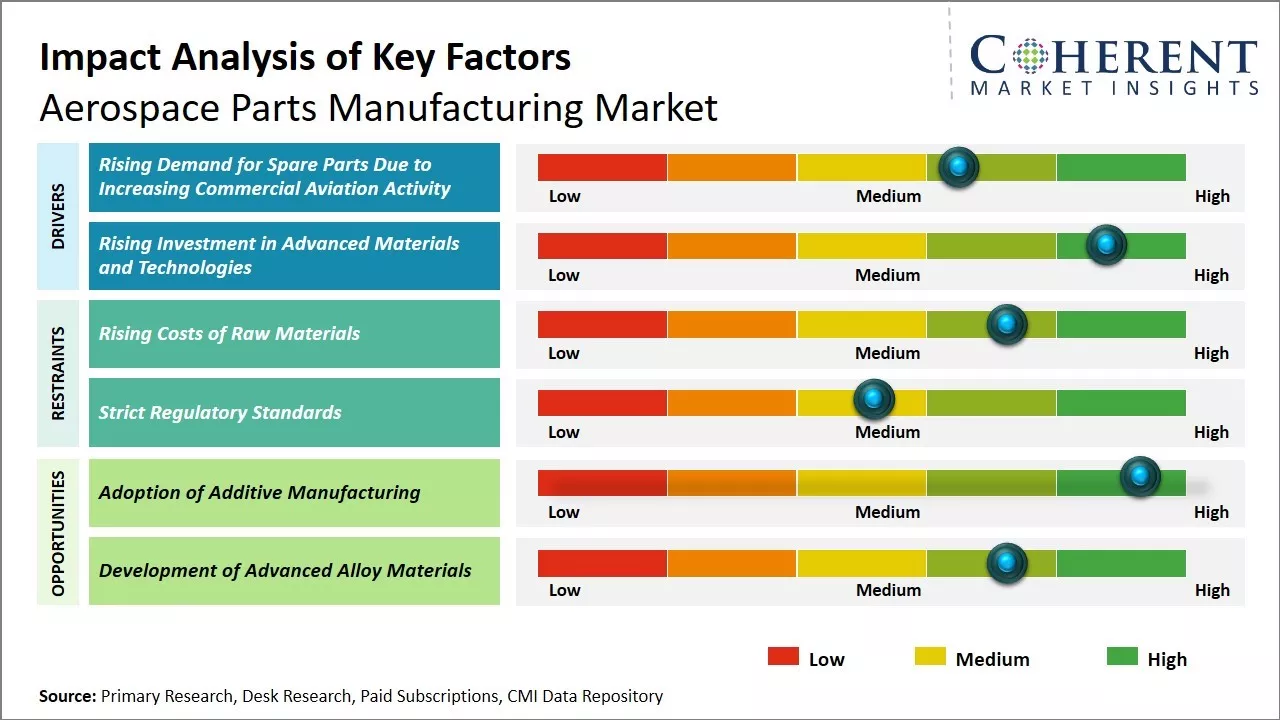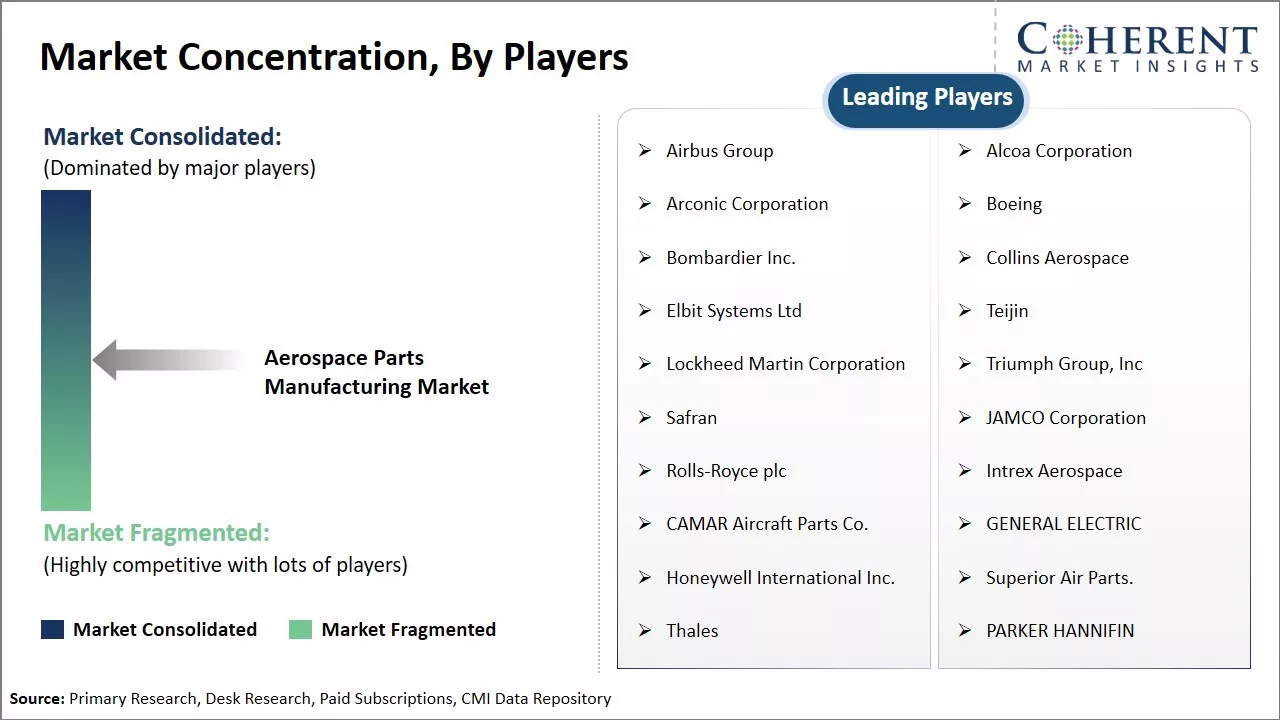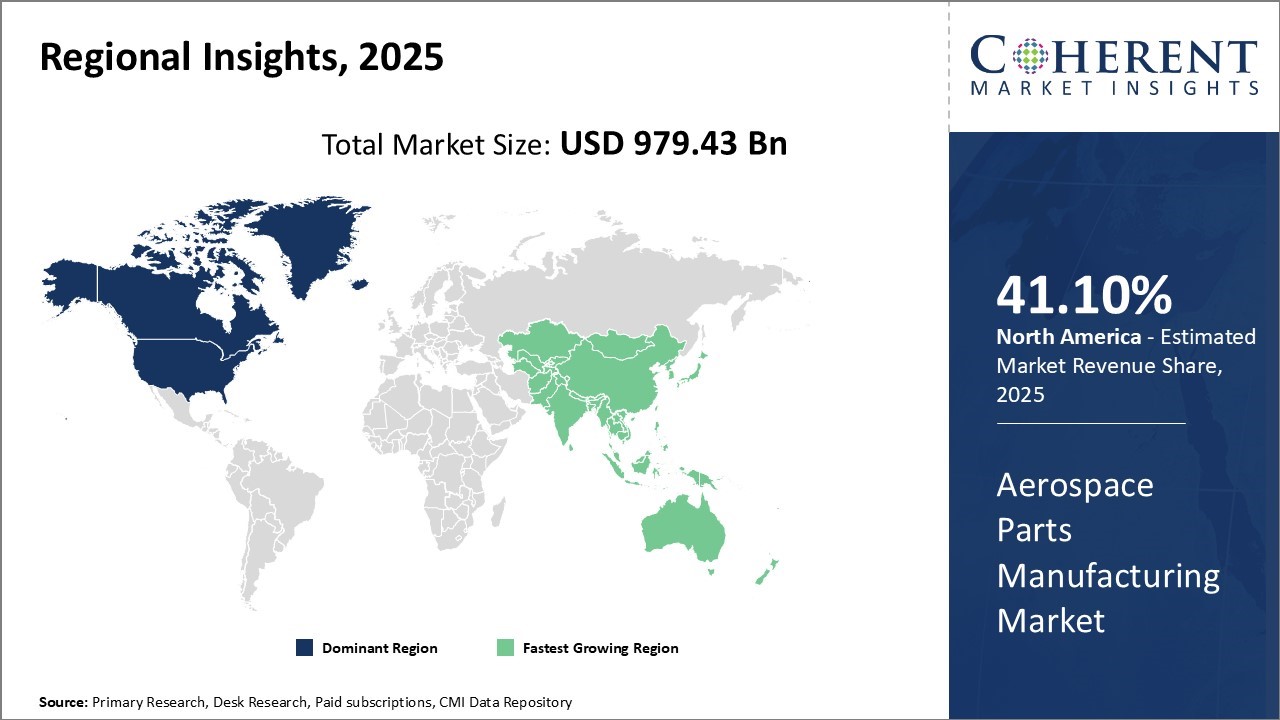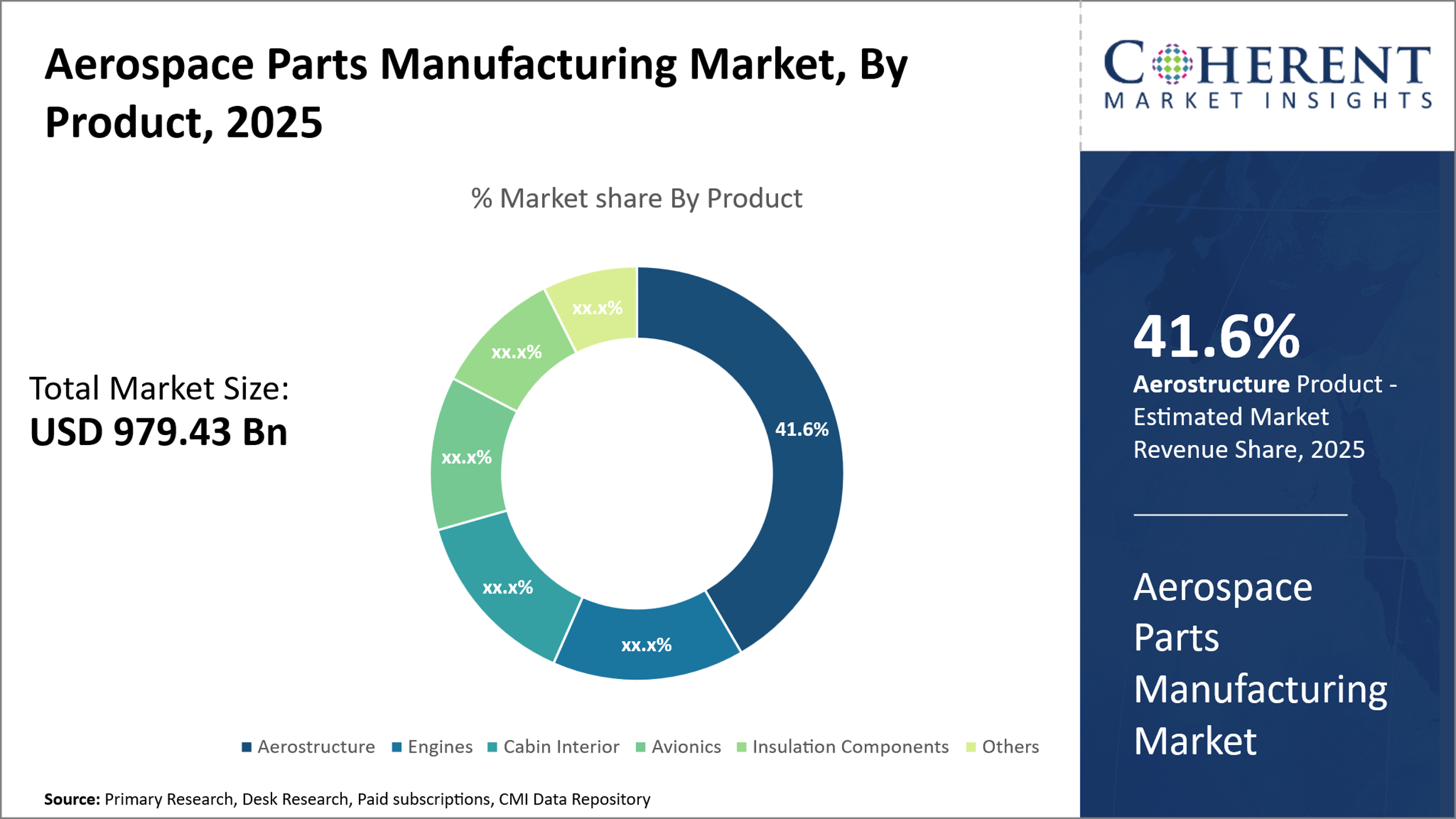Aerospace Parts Manufacturing Market Size And Share Analysis - (2025-2032)
The aerospace parts manufacturing market is estimated to be valued at USD 979.43 Bn in 2025 and is expected to reach USD 1,533.05 Bn by 2032, growing at a compound annual growth rate (CAGR) of 6.6% from 2025 to 2032.

To learn more about this report, Download Free Sample
Key Takeaways
- By Product, The Aerostructure Segment is projected to lead the global aerospace parts manufacturing market with a 41.6% share in 2025. This dominance is driven by its critical function in aircraft integrity and performance, encompassing key components such as fuselage, wings, and flight control surfaces.
- By Aircraft Type, Wide-Body Aircraft Type are anticipated to account for the highest market share at 55.1% in 2025, owing to their large cabin capacity and efficiency in long-haul operations.
- By Application, the commercial aircraft segment is expected to dominate the application category with a 51.1% share in 2025.
- North America is set to retain its leadership in the global aerospace parts manufacturing market with a 41.1% share in 2025.
Market Overview
The global aerospace parts manufacturing market is experiencing steady expansion, fuelled by increasing aircraft production, fleet modernization, and demand for fuel-efficient designs. Key growth is observed in the aero structure segment, which leads due to its structural significance and engineering complexity. Wide-body aircraft drive component demand for long-haul routes.
Current Events and its Impact on the Aerospace Parts Manufacturing Market
|
Current Event |
Description and its impact |
|
Surge in Commercial Aircraft Orders |
|
|
Supply Chain Realignment and Geopolitical Pressure |
|
|
Focus on Sustainable Aviation and Net-Zero Goals |
|
Uncover macros and micros vetted on 75+ parameters: Get instant access to report
Market Concentration and Competitive Landscape

To learn more about this report, Download Free Sample
Aerospace parts manufacturing Market Trends
- Rising Demand for Spare Parts Due to Increasing Commercial Aviation Activity
The demand for aerospace parts is increasing significantly due to the rising commercial aviation activities across major regions of the world. Many developing economies are experiencing fast economic growth and have emerged as lucrative aviation markets. This is leading to a surge in passenger traffic and aircraft fleet size among commercial airlines.
As more planes are pressed into service for commercial operations, the requirement for replacement parts and components is automatically rising. The existing aircraft also need regular maintenance and replacement of worn-out parts to ensure safety and performance. With more number of airplanes plying each day globally, the spares and repairs market is setting for strong growth.
The commercial aviation industry is envisioned to grow steadily in the coming years on the back of emerging middle classes, business travel needs, and improving regional connectivity in developing nations. Low-cost carriers have boosted regional air travel thanks to competitive fares and new routes. Legacy full-service carriers are expanding networks and upgrading fleets to tap emerging opportunities.
This is prompting manufacturers to ramp up aircraft production to take orders from major airlines across the world. As the fleet modernization plans of carriers come into effect, the need for original equipment manufacturer (OEM) parts and components is surging. Even the aftermarket or replacement demand sees a rise because of the expansion in flight hours from the existing aircraft.
In July 2025, The Times of India highlighted that Raphe mPhibr, an Indian drone startup, secured USD100 million in funding. The investment will enhance its aircraft design and manufacturing capabilities, reinforcing India’s push for self-reliant aerospace production under the Aatmanirbhar Bharat initiative.
- Rising Investment in Advanced Materials and Technologies
Aerospace manufacturers are making rising investments in advanced materials and cutting-edge technologies to produce lightweight as well as more durable and reliable parts for new-generation aircraft. With continuous emphasis on improving fuel-efficiency and emission standards, OEMs are focused on developing game-changing components and composites that can help reduce the overall weight of planes.
Alloys with enhanced strength are allowing thinner and more versatile designs. Advanced coating techniques are imparting better resistance to heat and corrosion. Composite materials like carbon fibre that are super strong yet light are gaining widespread adoption replacing traditional aluminium and alloys.
Additive manufacturing or 3D printing is one area attracting major R&D funding from both start-ups as well as industry stalwarts. These advanced technologies facilitate complex, customized, and optimized designs not possible with traditional techniques. 3D printed parts also enable efficient production with less material wastage. They help streamline supply chains and reduce time-to-market for new products.
The aerospace industry is working to certify critical components produced using. In July 2025, The Times of India reported that Nashik is poised to become a defence and aerospace manufacturing hub, anchored by HAL units and component manufacturers, as part of a new corridor stretching to Pune.
Aerospace Parts Manufacturing Market Insights, By Product
The aerostructure segment is projected to lead the global aerospace parts manufacturing market with a 41.6% share in 2025. This leadership is underpinned by the critical role aero structures play in ensuring aircraft performance, safety, and aerodynamic stability. Components such as the fuselage, wings, empennage, and flight control surfaces require cutting-edge engineering, high-strength alloys, and lightweight composites.
The segment continues to benefit from advances in carbon fibre technologies and automated assembly systems, especially in both commercial and military aircraft programs. Rising aircraft production rates and demand for lightweight, fuel-efficient models are expected to further support segment growth.
Aerospace Parts Manufacturing Market Insights, By Aircraft Type
Wide-body aircraft are anticipated to account for the largest market share of 55.1% in 2025, driven by increasing demand for long-haul international travel and air cargo transport. These aircraft offer large cabin capacity, dual-aisle configurations, and greater fuel efficiency per seat, making them ideal for intercontinental routes.
Airlines are increasingly investing in wide-body fleets such as the Boeing 787 and Airbus A350 to accommodate growing passenger volumes and freight operations. The segment also benefits from rising e-commerce activity and fleet renewals among full-service carriers, further boosting the demand for corresponding aerospace components.
Aerospace Parts Manufacturing Market Insights, By Application
The commercial aircraft segment is projected to dominate the aerospace parts manufacturing market with a 51.1% share in 2024. Factors such as global fleet expansion, increased passenger air travel, and airline investments in fuel-efficient models are key growth drivers. The rise in low-cost carriers and middle-class air travellers in emerging economies adds momentum to demand for new commercial aircraft.
Regulatory requirements around noise reduction and emissions are pushing OEMs to adopt advanced materials and upgrade part designs. This trend is creating strong demand across critical components, from engines and avionics to interior systems and structural assemblies.
Regional Insights

To learn more about this report, Download Free Sample
North America Aerospace Parts Manufacturing Market Trends and Analysis
North America is set to retain its leadership in the global aerospace parts manufacturing market, accounting for a dominant 41.0% share in 2025. This regional strength is anchored by the presence of major original equipment manufacturers (OEMs) and Tier 1 suppliers such as Boeing, Lockheed Martin, Raytheon Technologies, and General Electric Aviation.
The region benefits from a highly skilled workforce, robust supply chain networks, and sustained investments in research and development. In addition, substantial government defence budgets and the growing export of advanced aerospace components support long-term market growth. The integration of digital manufacturing technologies and strong collaboration between private industry and defence institutions further enhance North America's global competitiveness.
Europe Aerospace Parts Manufacturing Market Trends and Analysis
Europe plays a vital role in the aerospace parts manufacturing market, driven by its long-standing engineering expertise and strong industrial base. Countries such as Germany, France, and the UK are home to major aerospace companies like Airbus and Rolls-Royce, which invest heavily in advanced manufacturing capabilities.
EU-backed initiatives to promote sustainable aviation and innovation in lightweight composite materials are also shaping the regional landscape. With a focus on reducing emissions and enhancing fuel efficiency, Europe is steadily advancing its position through collaborative R&D and public-private partnerships, particularly in civil aviation and military programs.
Aerospace parts manufacturing market Dominating Countries
United States and Canada
The United States stands as a global leader in the aerospace parts manufacturing market, supported by a robust network of original equipment manufacturers (OEMs) and Tier 1 suppliers such as Boeing, Lockheed Martin, Raytheon Technologies, and General Electric Aviation. The country’s competitive edge is driven by a skilled workforce, deep defence spending, strong R&D infrastructure, and strategic collaborations between the public and private sectors. The U.S. also leads in the integration of advanced technologies like digital twins, AI, and additive manufacturing in aerospace production, ensuring continued market dominance.
Canada complements this regional leadership through its established aerospace hubs in Quebec and Ontario, hosting firms like Bombardier and Magellan Aerospace. Government initiatives promoting innovation, export development, and sustainable aviation technology strengthen Canada's contribution to the North American aerospace supply chain.
Market Report Scope
Aerospace Parts Manufacturing Market Report Coverage
| Report Coverage | Details | ||
|---|---|---|---|
| Base Year: | 2024 | Market Size in 2025: | USD 979.43 Bn |
| Historical Data for: | 2020 To 2024 | Forecast Period: | 2025 To 2032 |
| Forecast Period 2025 to 2032 CAGR: | 6.6% | 2032 Value Projection: | USD 1,533.05 Bn |
| Geographies covered: |
|
||
| Segments covered: |
|
||
| Companies covered: |
Airbus Group, Alcoa Corporation, Arconic Corporation, Boeing, Bombardier Inc., Collins Aerospace, Elbit Systems Ltd, Teijin, Lockheed Martin Corporation, Triumph Group, Inc, Safran , JAMCO Corporation, Rolls-Royce plc , Intrex Aerospace, CAMAR Aircraft Parts Co. , GENERAL ELECTRIC, Honeywell International Inc., Superior Air Parts., Thales, and PARKER HANNIFIN |
||
| Growth Drivers: |
|
||
| Restraints & Challenges: |
|
||
Uncover macros and micros vetted on 75+ parameters: Get instant access to report
Analyst Opinion ( Expert Opinion)
- The market is benefitted by rising global air travel, fleet modernization efforts, and defence procurement programs. Experts highlight that the sector’s resilience is underpinned by strong backlogs from OEMs like Boeing and Airbus, despite recent supply chain challenges.
- Experts emphasize that digital transformation, including automation, additive manufacturing, and data-driven maintenance solutions, is a central trend shaping the industry. These technologies are not only reducing production time and waste but also enabling greater design flexibility and cost-efficiency. Sustainability concerns are also prompting innovation in lightweight materials and greener manufacturing processes.
- Regionally, North America dominates due to its concentration of major OEMs, Tier 1 suppliers, and robust defence budgets. Europe follows closely, supported by Airbus-led production and EU initiatives promoting innovation. Asia Pacific, led by China and India, is emerging rapidly as nation’s ramp up local manufacturing and invest in aviation infrastructure.
Aerospace Parts Manufacturing Market: Key Development
- In March 2025, GE Aerospace announced plans to invest nearly $1 billion in its U.S. manufacturing facilities and supply chain during 2025. This includes $500 million in production enhancements, $100 million in material innovation, and $100 million in supplier development across 16 states, alongside hiring approximately 5,000 new employees. This substantial investment strengthens domestic engine and parts production, reduces lead times, supports regional economies, and advances the adoption of advanced materials and automation.
- In February 2025, UK-based Evolito was chosen to supply 32 axial-flux electric motors for Flying Whales’ LCA60T airship project, targeting entry into service by 2028. This marks a key milestone in hybrid-electric aerospace propulsion, creating new value chains for electrical component manufacturers and signalling future demand for specialized electric parts.
- In April 2024, GE Aerospace invested around ₹240 crore (~$30 million) to expand and modernize its manufacturing plant in Pune, India.
Market Segmentation
- By Product
- Engines
- Cabin Interiors
- Aerostructure
- Avionics
- Insulation Components
- Others
- By Aircraft Type
- Narrow Body aircraft
- Wide-body aircraft
- Turboprop aircraft
- By Application
- Commercial Aircraft
- Business Aircraft
- Military Aircraft
- By Region
- North America
- U.S.
- Canada
- Latin America
- Brazil
- Argentina
- Mexico
- Rest of Latin America
- Europe
- Germany
- U.K.
- Spain
- France
- Italy
- Russia
- Rest of Europe
- Asia Pacific
- China
- India
- Japan
- Australia
- South Korea
- ASEAN
- Rest of Asia Pacific
- Middle East
- GCC Countries
- Israel
- Rest of Middle East
- Africa
- South Africa
- North Africa
- Central Africa
- North America
- Key Players Insights
-
- Airbus Group
- Alcoa Corporation
- Arconic Corporation
- Boeing
- Bombardier Inc.
- Collins Aerospace
- Elbit Systems Ltd.
- Teijin
- Lockheed Martin Corporation
- Triumph Group, Inc.
- Safran
- JAMCO Corporation
- Rolls-Royce plc.
- Intrex Aerospace
- CAMAR Aircraft Parts Co.
- GENERAL ELECTRIC
- Honeywell International Inc.
- Superior Air Parts.
- Thales
- PARKER HANNIFIN
Sources
The Stakeholders Consulted
- Aerospace OEMs and Tier 1 & Tier 2 suppliers
- Manufacturers of aircraft structural, engine, and landing gear components
- Defense contractors and military procurement officers
- MRO (Maintenance, Repair, and Overhaul) service providers
- Aviation and aerospace materials engineers
- Civil aviation regulatory authorities and export control agencies
- Research and academic institutions focused on aerospace design and propulsion systems
- Government departments for defense production, civil aviation, and industrial development
Databases Opened
- U.S. Department of Transportation (DOT) – Aviation Manufacturing Statistics
- Federal Aviation Administration (FAA) – Aerospace Manufacturing & Aircraft Certification Data
- Ministry of Civil Aviation (India) – Aircraft Industry Reports
- SIPRI (Stockholm International Peace Research Institute) – Military Expenditure and Procurement Data
- World Bank Open Data – Trade, Export, and Manufacturing Indicators
- ScienceDirect, SpringerLink – Aerospace and Mechanical Engineering Journals
Magazines & Trade Publications
- Aviation Week & Space Technology
- Aerospace Manufacturing Magazine
- Air & Space Magazine
- Defense News – Aerospace & Industry Section
- FlightGlobal – Manufacturing & MRO Insight
- Manufacturing.net – Aerospace Segment
Scientific and Industry Journals
- Journal of Aerospace Engineering
- International Journal of Aerospace Science and Technology
- Journal of Aircraft (AIAA)
- Composite Structures
- Materials Science and Engineering A
Newspapers & Media Outlets
- Reuters – Global Aerospace & Defense News
- Bloomberg – Aviation and Manufacturing Markets
- The Wall Street Journal – Aerospace & Technology
- The Economic Times – Aviation & Industry Section
- Business Standard – Manufacturing and Export News
Associations and Regulatory Bodies
- Federal Aviation Administration (FAA), U.S.
- European Union Aviation Safety Agency (EASA)
- International Air Transport Association (IATA)
- Aerospace Industries Association (AIA)
- Society of Indian Aerospace Technologies and Industries (SIATI)
- Defence Research and Development Organisation (DRDO), India
Public Domain Sources
- U.S. Bureau of Labor Statistics – Aerospace Manufacturing Employment Reports
- European Commission – Aviation Manufacturing and Emission Reduction Initiatives
- SIPRI – Military Aerospace Trade and Production Insights
- United Nations Comtrade – Global Aerospace Trade Flows
- World Bank – Air Freight and Export-Import Metrics
Proprietary Research Elements
- CMI Data Analytics Tool
- Proprietary CMI Repository of Aerospace Market Data (covering past 8 years)
- CMI Expert Interviews and Transcripts (with aerospace engineers, production planners, and procurement executives)
Share
Share
About Author
Suraj Bhanudas Jagtap is a seasoned Senior Management Consultant with over 7 years of experience. He has served Fortune 500 companies and startups, helping clients with cross broader expansion and market entry access strategies. He has played significant role in offering strategic viewpoints and actionable insights for various client’s projects including demand analysis, and competitive analysis, identifying right channel partner among others.
Missing comfort of reading report in your local language? Find your preferred language :
Transform your Strategy with Exclusive Trending Reports :
Frequently Asked Questions
EXISTING CLIENTELE
Joining thousands of companies around the world committed to making the Excellent Business Solutions.
View All Our Clients

